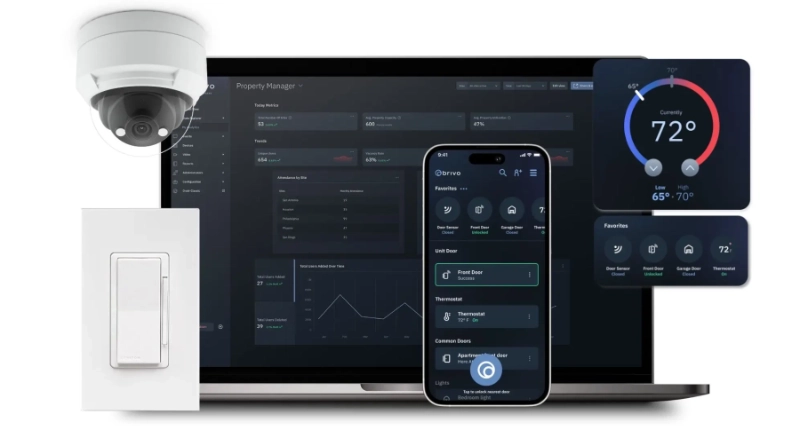As the joke goes, “When is a door not a door? When it’s a jar (ajar).” Thinking about that question more literally, does a door fulfill its access control function when it’s ajar? A common perception is that access control serves only to keep bad people out. While that’s certainly a paramount concern, access control provides multiple services. It may make sense to keep an interior door ajar, for example, in a post-Covid return to the workplace when access by an adversary is unlikely, staff do not want to touch door handles, and the organization is trying to optimize safe airflow.
Access control has been around for a long time and it has evolved. Ancient castles had moats and drawbridges, today we have cloud-based, integrated access control systems available. In the age of digital transformation, some of the most beneficial aspects of modern access control have been left out of the conversation. When people hear the term “access control” some may envision cumbersome, complicated systems, but that is not the case anymore.
It’s time to debunk the common misconceptions around access control:
1. It’s Cumbersome and Clunky
Awkward, clumsy, dysfunctional, outdated. These are some terms to describe legacy access control systems. Proprietary software locks in users to specific solutions, limiting flexibility, scalability, convenience, and versatility. Cards are shared, lost, stolen, and have to be replaced, requiring someone to print and code new credentials. Alarm conditions may require someone to report to a physical reader, panel, or locking mechanism. On-premises systems can be easily breached to reveal personal data, building usage patterns, and other sensitive information.
Cloud-based options dispose of on-site management infrastructure, and mobile systems eliminate the need for keycards, fobs, or other credentials that frequently disappear and cost time and money to replace. When your access control moves to a cloud provider, dedicated experts manage the cybersecurity and upgrades of the overall solution. Like your smartphone that gets automatic updates pushed to fix bugs or vulnerabilities or to upgrade features, cloud-based access control works the same. The latest generation of hardware and software provides unlimited options for the growth and integration of other systems.
2. It is Resource Intensive
Let’s face it. Your IT team has a lot of work on its hands, everything from ensuring compliance and responding to help desk requests to developing business applications and writing program code. In and of itself, maintaining an on-premises access control system is not a big lift. However, it takes staff from more pressing business needs. When the maintenance of the cloud platform is performed by the provider your staff is relieved of that burden and are freed to add value elsewhere in the organization. Cloud-based access control leverages the expertise and size of the provider. Brivo installations and integrations, for example, are simple. With its open API, countless systems, from visitor management and video surveillance to health monitoring and HR management, countless complementary systems integrate snugly. Software updates and patches automatically flow from the cloud to the customer without requiring your IT department’s involvement.
3. It Requires Onsite Management
On-premises systems indeed require onsite management. Administrators must be physically present to add or delete users or change access permissions or parameters. Cloud-based solutions, by contrast, empower administrators to manage access from anywhere with network access. Does a key employee need access in the middle of the night? Bleary-eyed drives to the office are a thing of the past. Access can be granted in a couple of clicks from a smartphone or tablet. Has a staff member lost or misplaced a keycard? Forget about printing and encoding a new card and physically handing it to the employee. Mobile solutions use an app on staff phones as a physical credential, and staff rarely forget to tote their phone wherever they go.
4. Upfront Costs to Modernize Systems Are High, Even Prohibitive
The initial expense associated with upgrading to efficient access control is nothing compared to savings associated with the added security, time savings and the increased revenue associated with offering flexible workspaces, and tenant attraction and retention. Moving from an on-premises system to the cloud is very cost-effective. With cloud services, the client pays a monthly licensing fee. While seemingly costly, the aggregate fees are often more cost-effective over time than costs hidden in on-premises systems. For example, server and system maintenance and patching add costs. Moreover, on-premises systems require a separate license for each location—and a separate charge—making the costs increase. With on-premises systems, large organizations with multiple facilities pay multiple license fees and maintain separate servers at each location.
Cloud providers make it financially prudent, even financially compelling, to move on from on-premises systems. For example, Brivo Complete tailors subscription options to meet your budget, providing peace of mind of a predictable price each month. That includes a lifetime guarantee on hardware you obtain via Brivo. In addition, Brivo offers a financing program for upgrades to the cloud, new multisite installations, and integrations with existing systems. Installment plans ranging from one to six years help manage your business’s cash flow.
5. On-Premises Systems Are More Secure Than Cloud Solutions
It’s natural to trust your IT staff more than the personnel at a cloud provider. After all, you know them, worked with them and witnessed their ability and professionalism. But many other priorities compete for their time and attention, and the security of an access control system tumbles to the bottom of that list. By contrast, cloud service providers assign dedicated specialists to data security and privacy issues. It’s their top priority, and they have the expertise and experience to excel. Moreover, your IT staff might miss, or delay in implementing, critical updates, upgrades, and patches, creating periods of network exposure. Finally, on-premise systems often have one point of failure—the system administrator’s password. One hack or phish can expose the whole system. Many cloud providers have layered, nuanced and more secure setups.
Today’s answer to “When is a door not a door?” might be “When it uses cloud-based access control.” A door transforms from a mere barrier to a cost-effective, powerful tool to keep adversaries out, let credentialed people into the right spaces at the right time, and provide data insights that benefit the organization. They can be centrally managed, integrated, and optimized seamlessly and cost-effectively.
See modern cloud-based access control in action: Register for a monthly demo webinar.













